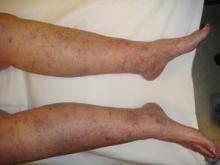On the heels of the Food and Drug Administration's recent approval of polidocanol injections for the treatment of spider and reticular veins, Dr. Margaret W. Mann is working to educate her colleagues on how to cure the more serious implications of venous disease.
An estimated 55% of American women and 45% of American men suffer from some form of vein problem. Varicose veins affect one out of two people aged 50 and older, according to the Department of Health and Human Services.
"So it is very much not a cosmetic issue," Dr. Mann said at a cosmetic dermatology seminar sponsored by Skin Disease Education Foundation in Santa Monica, Calif. "And it is important to treat these patients before they develop serious sequelae to their disease."
Varicose veins are often inherited. If both parents have varicose veins, a person has an 89% risk of developing the condition; if one parent is affected, the risk is 47%; and if neither parent has them, the risk decreases to 20% (J. Dermatol. Surg. Oncol. 1994;20:318-26).
"When I approach a patient with telangiectasia and varicose veins, I know that it can be just the tip of the iceberg," said Dr. Mann, codirector of the dermatologic surgery and laser center at the University of California, Irvine. Early treatment is optimal to prevent worsening of the disease.
The path to curing venous disease lies in looking beyond the visible and treating the root of problem. Patients with severe spider veins along the ankle, prominent reticular veins greater than 5 mm, or palpable varicosities likely have underlying venous insufficiency, said Dr. Mann. These patients should undergo ultrasound examination to delineate their venous anatomy prior to treatment.
"In patients with outflow obstruction, varicosities must not be ablated because they are an important bypass pathway allowing blood to flow around the obstruction," explained Dr. Mann. "Specific diagnostic tests can distinguish between patients who will benefit from ablation of dilated superficial veins and those who will be harmed by the same procedure."
In patients diagnosed with great saphenous vein insufficiency, Dr. Mann recommends minimally invasive treatment with endovenous ablation and microphlebectomy. It is essential, according to Dr. Mann, to treat their underlying disease prior to treatment of their spider veins with the mind set that "everything is connected in a hierarchal way" and "therapy must start from a top down approach."
Dr. Mann disclosed she is a paid consultant with BioForm Medical (acquired by Merz Pharmaceuticas). SDEF and this news organization are owned by Elsevier.


